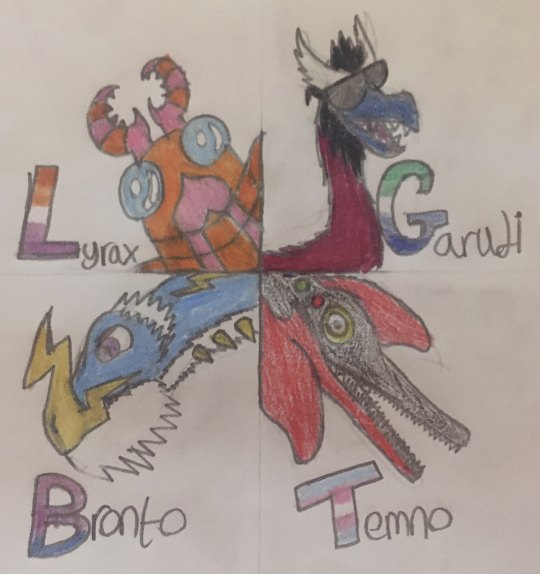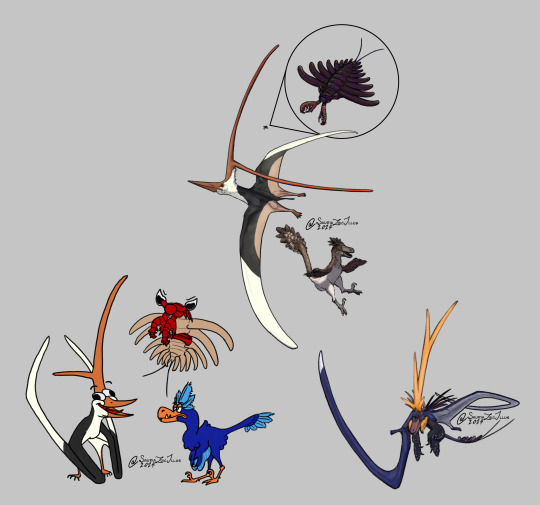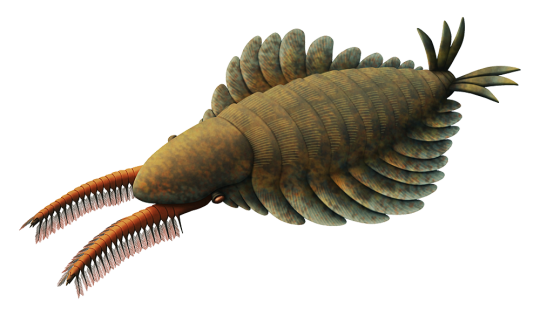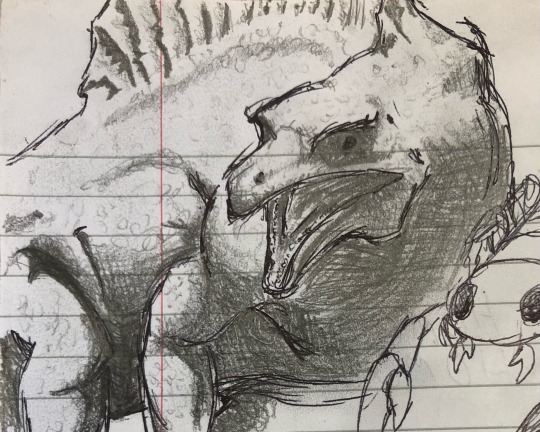#lyrarapax
Text

Clementine and some of her cousins!
#one is not like the other. can you tell who it is?#Hurdia victoria#Schinderhannes bartelsi#Aegirocassis benmoulai#Aegirocassis#Anomalocaris canadensis#Anomalocaris#Balhuticaris voltae#Balhuticaris#Kylinxia zhangi#Lyrarapax unguispinus#Lyrarapax#Amplectobelua symbrachiata#donutdrawsthings#oc#ocs#original character#clementine#character design#cambrian period#cambrian#cambrian explosion#devonian#paleomentary#paleozoic#paleontology#paleoart#paleoblr#anomalocaris oc#radiodont
67 notes
·
View notes
Text

My favorite guys!! the radiodonts :)
Alt versions under read more 👁


3-eyed Peytoia version and also a transparent one!
#radiodont#anomalocaris#aegirocassis#hurdia#peytoia#cambroraster#stanleycaris#amplectobelua#lyrarapax#caryosyntrips#tamisiocaris#cambrian#ordovician#devonian#paleo art#paleoart#paleoblr#pixel art#pattern#schinderhannes#radiodonta#paleozoic
212 notes
·
View notes
Text
Lyrarapax unguispinus fighter girl
hold up, lemme cook, Lyrarapax unguispinus fighter girl
(very much inspired by Jun and TheAmazingSpino's anthropomorphisation techniques)
if i ever clean up this sketch you'll be able to find a link to it here

#radiodont#paleoart#artists on tumblr#digital artwork#digital art#digital illustration#anime girl#anime style#Lyrarapax unguispinus#Lyrarapax#sketch
6 notes
·
View notes
Text
WE'RE ROLLING WITH THE

Happy Pride Month y'all!
#fossil fighters#fossil fighters champions#vivosaur#fossil fighters fanart#vivosaurs#pride#pride month#garudimimus#temnodontosaurus#brontosaurus#lyrarapax#dinosaur#dinosaurs#ichthyosaur#cambrian
27 notes
·
View notes
Text

Lyrarapax was an early genus of arthropod from an order known as the Radiodonts. Radiodonts were a diverse and dominant group during the Cambrian period and possibly even later. These arthropods are characterized by their hard shell-like armor, numerous fins, and appendages on their heads for catching prey. Some of these animals would grow to massive sizes, at least by the standards of the time.
Lyrarapax was small for a radiodont, measuring about 8 cm in length. It lived approximately 520 million years ago and fed on just about anything it could get its claws on. Mostly small soft bodied animals. Like many other animals at the time, it had a jawless mouth underneath its head and used its lobster-like claws to catch and tear apart prey.
#Lyrarapax#journey through time#paleoart#paleontology#evolution#radiodont#cambrian#paleozoic#arthropods
6 notes
·
View notes
Text

DINOVEMBER DAY 1: 520MYA, STAGE 3 OF THE CAMBRIAN; YUNNAN, CHINA
It is the Cambrian period, and the warm sunlit seas of Southern China are home to a vibrant sponge-reef brimming with life. The creatures of the Cambrian are strange to us in the Holocene, as this period of time is a time of great experimentation in bodyplans thanks to the evolution of a very special type of organ: eyes. Predators can now see their prey, and vice versa, so the pace of life has sped up considerably, and everyone has had to adapt. Many organisms now have hard shells, spiny defences, or increased mobility to protect themselves from these new sighted predators.
One such predator is this Lyrarapax, cruising through a small group of Haikouichthys. You might be more familiar with her Canadian cousin Anomalocaris. At around half a metre long, Lyrarapax is one of the top predators of the Chengjiang biota; her strange arm like protrusion are derived from the filter feeding appendages of her ancestors, and she uses them to grab prey such as trilobites and pass them to the crushing wheel-like mouth on the underside of her head.
Arthropods like her dominate the Cambrian seas, and along with cephalopod molluscs, will rule the Ordovician as well. Primitive chordates like Haikouichthys will remain in their shadow… for now.
#dinovember#Dinovember 2022#palaeontology#palaeoart#anthem posts#anthems art#Lyrarapax#anomalocaris#Haikouichthys#cambrian
24 notes
·
View notes
Text
Subjectively Paleoart Styles
Subjectively recently released a video talking about different styles of paleoart and made a call to action to make your own, so as a paleoartist i had to engage with all three prompts, scientific, fantasy, and cartoon (style explanation in alt text)




#paleoart#paleontology#digital art#artists on tumblr#digital artwork#palaeoart#digital illustration#id in alt text#sciart#fantasy#fantasy art#fantasy monster#cartoon#cartoon style#cartoon art#dinosaur#pterosaur#radiodont#Nyctosaurus#Kuru#Lyrarapax unguispinus
52 notes
·
View notes
Text

Another #paleostream sketch
I frequently critique alien designs in pop culture for being incredible unimaginative. One reason is that our own plants history has seem numerous clades come and go that put Hollywoods creativity to shame.
Here some Lyrarapax (a radiodont) attack a Yuyuanozoon, the largest known member of a clade called Vetulicolia
500 notes
·
View notes
Photo





Time for some more PBS Eons commission work!
The radiodonts Lyrarapax and Tamisiocaris, from "How Plankton Created A Bizarre Giant of the Seas"
https://www.youtube.com/watch?v=G0oKBPZODhM
The rhynchocephalians Sphenotitan, Clevosaurus, and Kawasphenodon, from "When Lizards Took Over the World"
https://www.youtube.com/watch?v=peeX3PKOE_w
———
Nix Illustration | Tumblr | Pillowfort | Twitter | Patreon
#science illustration#paleontology#paleoart#palaeoblr#pbs eons#lyrarapax#tamisiocaris#radiodonta#dinocaridida#arthropod#invertebrate#spenotitan#clevosaurus#kawasphenodon#sphenodontia#rhynchocephalia#lepidosauria#reptile#art
1K notes
·
View notes
Text
First Vivos of June (Happy Pride Month!)
Got three more vivosaur designs to show off today

First of all we have the Sacred Sky King, Garudi! Named after the King of Birds in Hinduism, this ornithomimid was a close cousin of the mighty Deinocheirus, though it wasn't nearly as big as either its cousin or its namesake. Garudi has extremely high attack for its size, while retaining the speed and amazing support effects that its relatives are known for!

Next up we have the Shrimpish Warrior, Lyrax! A smaller relative of Anomalocaris, this little critter is important for having its brain and nervous system preserved in fossil remains, helping scientists determine the evolutionary history of anomalocarids and other Cambrian radiodonts. Lyrax comes equipped with Enflame status when in battle meaning it'll dish out great damage on the first turn.

And lastly we have the mighty God of Thunder, Bronto! With both tremendous attack and colossal defense, this massive dinosaur is only weighed down by its high FP usage and debilitating support effects. The fossils of this guy are super rare but the beast is more than worth the grind in battle.
Got a lot more stuff planned for the next few days, some of which might be a little different from my usual vivosaurs, which I am SURE some of y'all will like 👀.There's also another surprise that should be coming either tomorrow or later today that I can't wait to show you all!
Goodbye for now, best wishes, and Happy Pride Month!!!!
#fossil fighters champions#fossil fighters#vivosaur#fossil fighters fanart#vivosaurs#brontosaurus#lyrarapax#garudimimus#dinosaur#sauropod#cambrian#ornithomimosaur
13 notes
·
View notes
Text

DINOVEMBER DAY 2: 420MYA, PRIDOLI STAGE; ESTONIA
(Sorry the lighting is a bit poorer today, it’s the best I could get. EDIT: replaced w/ a shot w/ better lighting. Suggested listening whilst reading is ‘Meet Brontoscorpio’ from the Walking with Monsters ost)
It is the Silurian period, and a giant 2.5m long sea scorpion, Pterygotus, chases a group of primitive fish called Dermataspis. This is reminiscent of the the Cambrian, some 100 million years ago, but times have changed. Glaciation at the South Pole at the end of the Ordovician caused sea levels to fall and ocean temperatures to drop, threatening the tropical reefs that life had thrived in up until that point. This lead to a mass extinction event, the first of the Phanerozoic eon, bringing to an end many of the diverse and and varied lineages of that emerged during the Cambrian.
Of those that survived, the eurypterids, or sea scorpions, were one of the only arthropod groups to find a position of power in a post extinction world, evolving into some of the largest organisms in the Silurian seas. The trilobites also remain numerous, but long gone are radiodonts like Lyrarapax. Surprisingly, the most significant animals in this new world are relatives of the tiny Haikouichthys: the fishes. With muscular tails to power themselves through the water, a complex heart that gives them extra stamina, and skeletons of cartilage and bone protecting their vital organs, fish occupy a variety of roles from armoured bottom feeders like Tremataspis to open water oceanic predators. The fish are becoming so numerous that the Silurian is often referred to as the age of fishes.
The Arthropods, however, have began pushing a new frontier that the fish cannot reach: plant colonisation means that the air is now breathable, and although most land is still barren desert, small millipede like creatures have taken the first steps out of the water.
15 notes
·
View notes
Text

I posted 19,598 times in 2022
That's 13,345 more posts than 2021!
118 posts created (1%)
19,480 posts reblogged (99%)
Blogs I reblogged the most:
@strawberry-crocodile
@catwaifuwu
@goldenvicious
@emotionalmilkshake
I tagged 1,672 of my posts in 2022
#ingo and emmet - 43 posts
#anthem posts - 30 posts
#morbposting - 26 posts
#walking with dinosaurs - 24 posts
#chased by dinosaurs liveblogging - 23 posts
#jerma moment - 23 posts
#submas - 21 posts
#dinovember - 13 posts
#transfem hunter - 12 posts
#dinovember 2022 - 12 posts
Longest Tag: 139 characters
#his name is asac shrader (its hank) aaaasac shraaadeeer (his name is hank) aaaasac shraaadeeer (its time for you to leave me) fuck yourself
My Top Posts in 2022:
#5

I can assure you this Edaphosaurus that I drew in the corner of my notebook is going to be 10 times better than anything I’ll do for Dinovember next month (ft. Pterygotus)
Also this is the first time I’ve posted art to tumblr for a while; as I’ve said, I’m going to be doing Dinovember next month so you’ll probably see more of my silly doodles in the future. Stay tuned!!
19 notes - Posted October 11, 2022
#4

DINOVEMBER DAY 1: 520MYA, STAGE 3 OF THE CAMBRIAN; YUNNAN, CHINA
It is the Cambrian period, and the warm sunlit seas of Southern China are home to a vibrant sponge-reef brimming with life. The creatures of the Cambrian are strange to us in the Holocene, as this period of time is a time of great experimentation in bodyplans thanks to the evolution of a very special type of organ: eyes. Predators can now see their prey, and vice versa, so the pace of life has sped up considerably, and everyone has had to adapt. Many organisms now have hard shells, spiny defences, or increased mobility to protect themselves from these new sighted predators.
One such predator is this Lyrarapax, cruising through a small group of Haikouichthys. You might be more familiar with her Canadian cousin Anomalocaris. At around half a metre long, Lyrarapax is one of the top predators of the Chengjiang biota; her strange arm like protrusion are derived from the filter feeding appendages of her ancestors, and she uses them to grab prey such as trilobites and pass them to the crushing wheel-like mouth on the underside of her head.
Arthropods like her dominate the Cambrian seas, and along with cephalopod molluscs, will rule the Ordovician as well. Primitive chordates like Haikouichthys will remain in their shadow… for now.
21 notes - Posted November 1, 2022
#3
Hawks can commit arson
23 notes - Posted May 26, 2022
#2
youtube
OH MY GOD GUYS????? NEW PREHISTORIC DOCUMENTARY FEATURING NIGEL MARVEN????
Seriously though, Agate looks to be an amazing project, with three 15 minute episodes taking us on a tour of Miocene Nebraska. It’s a crowdfunded project, so if you can spare the change, go and check out their kickstarter!
35 notes - Posted November 23, 2022
My #1 post of 2022
This person is trying to publish their paper on Daspletosaurini! I'm helping the only way I know how to.
41 notes - Posted May 19, 2022
Get your Tumblr 2022 Year in Review →
#tumblr2022#year in review#my 2022 tumblr year in review#your tumblr year in review#Youtube#woag.. ive been poasting#anthem posts
3 notes
·
View notes
Photo

Newly-described anomalocaridid Lyrarapax unguispinus. Just 12cm long (4.7in), the fossils of this 520 million-year-old Chinese species have exquisitely-preserved brains -- the structure of which help to confirm a shared ancestry with velvet worms and basal arthropods.
All the reference images I could find focus on the underside of Lyrarapax, so this reconstruction is pretty speculative regarding the head shield shape and possible dorsal flaps.
And while the brain discovery is really neat, look at those flippers! While Schinderhannes looks like an anomalocaridid trying to be a fish, Lyrarapax almost looks like one trying to be a penguin.
#art#paleoart#paleontology#lyrarapax#anomalocaridid#radiodonta#dinocaridida#arthropod#stem arthropod#sketchy stuff#dorsal flaps for ALL the anomalocaridids!#also I only just noticed this is almost the exact same pose as that scratchboard Anomalocaris I did a while back#whoops
211 notes
·
View notes